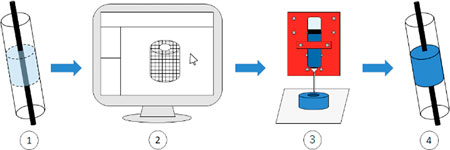| Feb 26, 2020 | |
3D-printing metal-organic framework solids for high-pressure gas storage and separation |
|
| (Nanowerk Spotlight) Metal-organic frameworks (MOFs) rank among the best materials for catalysis, gas storage and gas storage and processing. So far, more than 20 000 different MOFs have been fabricated and characterized. | |
| "While MOFs are produced as loose powders and tested as such at the laboratory scale, applications generally require easy-to-handle solids with a specific shape and sufficient mechanical robustness to withstand long-term damaging stresses, such as attrition and hydrostatic pressure," Jérémy Dhainaut, a researcher at the Unité de Catalyse et Chimie du Solide (UCCS), Université de Lille (he was a post-doctoral researcher at the Institute for Integrated Cell-Material Sciences (WPI-iCeMS) at Kyoto University at the time of this work). "In our recent work, we focused on the preparation of MOF-based solids by robocasting with a controlled macroscale morphology and superior textural properties." | |
| A crucial issue for designing MOF-based solids is about finding the best comprise between the material's porosity and its mechanical resistance in relation to a specific application. | |
| As the team reports in ACS Applied Materials & Interfaces ("Formulation of Metal-Organic Framework Inks for the 3D Printing of Robust Microporous Solids toward High-Pressure Gas Storage and Separation"), they used a modified 3D printer for the controlled deposition of inks, formulated from four different MOF powders (HKUST-1, CPL-1, ZIF-8, and UiO-66-NH2) and in the presence of low proportions of a binder and a plasticizer. | |
| "This type of robocasting – a microextrusion technique based on the controlled, layer-by-layer deposition of a paste – presents the advantages of giving us perfect control on the size and morphology of the final solid, as well as having a very limited effect on the materials porosity," explains Dhainaut. "In the presence of a small amount of a cellulose-derived binder, the solids are not only self-standing after drying but they also display a consequent robustness." | |
| He points out that very few techniques can meet all of these conditions at once, making it particularly appropriate for a wide range of applications. | |
 |
|
| Typical process workflow based on the methodology developed herein: (1) identification of the need, (2) computer-assisted modeling of the fitting solids, (3) MOF-based ink deposition using a 3D printer, and (4) evaluation of the performance of the solid. (Reprinted with permission by American Chemical Society) | |
| Promising for future applications is the fact that all characterization techniques indicate that the 3D-printing process only slightly impacts the MOFs' textural and structural properties, and that they show a comparable performance to the powders for gas storage (carbon dioxide, methane) and separation (ethylene/ethane). | |
| Indeed, the solids displayed a permanent microporosity that is comparable to that of the initial powders. They also present a high compressive strength that is only 1-2 orders of magnitude lower than that of the dense binderless pellets. | |
| Usually, when porous powders are shaped, there is a loss of performance related to the presence of binders in excess – blocking the pores accessibility or/and to the densification process – partially collapsing the pore network. Especially MOFs are composed of elements (metallic clusters and organic compounds) which are weakly bounded to each other. | |
| "Previous studies have shown that densification techniques used at the industrial scale, when applied to MOFs, lead to an irreversible loss of performance," says Dhainaut. "This is not the case when using our robocasting technique." | |
 |
|
| Photographs of CPL-1-based objects printed under the same conditions with inks formulated with 35 wt % (a) and 51 wt % (b) of CPL-1. (Reprinted with permission by American Chemical Society) (click on image to enlarge) | |
| The team's results are still preliminary and there are several improvements that need to be achieved prior to developing practical applications. | |
| For instance, they are planning to print more viscous pastes, in order to increase the loading of MOF powders and therefore to improve the final robustness as well as the volumetric uptake (the volume of gas a material of a specific volume can adsorb) of the 3D-printed materials. | |
| Moreover, they will start printing more porous powders soon, which are more fragile but would significantly increase the gravimetric uptake (the weight of gas a material of a specific weight can adsorb) of the final materials. | |
| High volumetric and gravimetric uptakes have been set by the U.S. Department of Energy as a prerequisite for hydrogen and natural gas vehicles, and both have rarely been met by the same material. | |
| "We believe that our study paves the way to the preparation of highly porous MOF-based solids with designs completely adaptable to their applications: microreactors, adsorbent beds, or separation membranes with specific morphologies, to name a few," Dhainaut concludes. | |
 By
Michael
Berger
– Michael is author of three books by the Royal Society of Chemistry:
Nano-Society: Pushing the Boundaries of Technology,
Nanotechnology: The Future is Tiny, and
Nanoengineering: The Skills and Tools Making Technology Invisible
Copyright ©
Nanowerk LLC
By
Michael
Berger
– Michael is author of three books by the Royal Society of Chemistry:
Nano-Society: Pushing the Boundaries of Technology,
Nanotechnology: The Future is Tiny, and
Nanoengineering: The Skills and Tools Making Technology Invisible
Copyright ©
Nanowerk LLC
|
|
|
Become a Spotlight guest author! Join our large and growing group of guest contributors. Have you just published a scientific paper or have other exciting developments to share with the nanotechnology community? Here is how to publish on nanowerk.com. |
|
